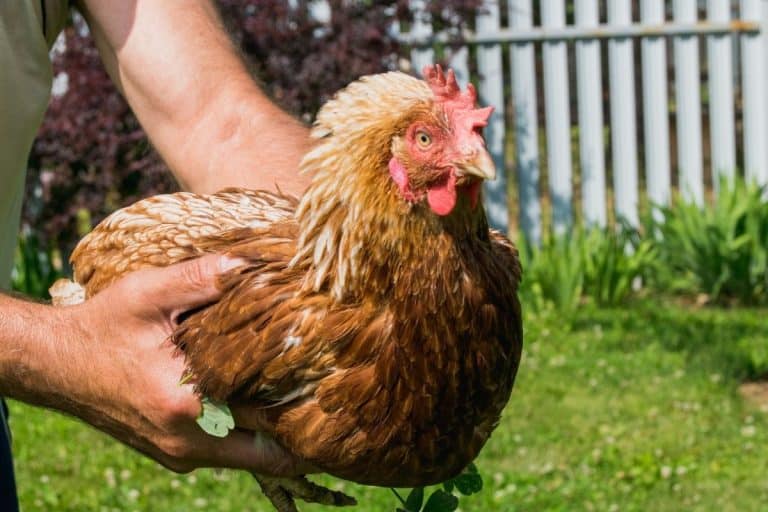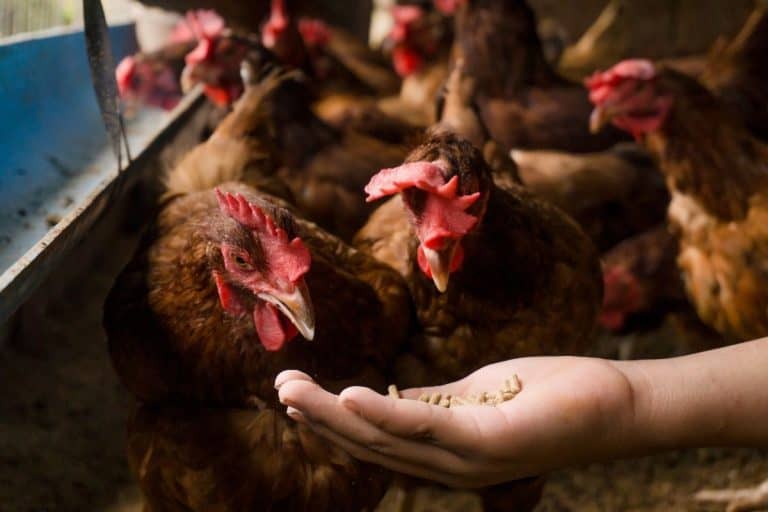Do Chickens Communicate With Each Other? How?
Chickens are one of the most commonly kept poultry birds in the world. Chickens, despite laying fresh eggs and providing us with meat, exhibit a variety of quirky behaviors, and many chicken owners wonder whether chickens can communicate with one another.
Chickens can communicate with one another. Chickens are intelligent and social creatures that have a language made up of various sounds and noises that they use to convey messages and signals to other chickens.
If you own chickens or are simply fascinated by them, you must be wondering how these birds communicate with one another and what is the purpose of their communication. Read on to learn everything there is to know about chicken communication and language from a small animal veterinarian.
Hey chicken buddies: Quick heads-up before going further! I've put together a list of stuff I use and love for my flock. If you're curious about what keeps my hens happy, click here to find out.
Do Chickens Communicate With Each Other? How?
Chicks do communicate with one another through the various sounds they make. Although it may come as a surprise to some of us, it is true. In fact, chickens begin communicating even before they enter this world; yes, you read that correctly.
When chickens are unhatched, they start communicating with one another. Almost 24 hours before hatching, chicks begin to make peep sounds scientifically referred to as “clicking” to alert the mother and other unhatched chicks that they are about to hatch.

Chicks communicate with each other from inside the eggs by making peep sounds to synchronize the hatching process.
Chickens, unlike humans, lack a larynx; instead, their voice box is known as a syrinx, which is located at the tracheal bifurcation. Unlike other animals, the chicken syrinx lacks vocal folds and produces sound through vibrations of its walls as air passes through it.
Chickens can communicate with one another and produce a variety of sounds thanks to the syrinx.
Chickens communicate with one another to send a variety of messages and signals. Chickens are very social creatures that communicate with each other to establish their pecking order, find food, and avoid predators, among other things.
Wait, I have some recommendations for you!
Before you go any further, I want you to take a look at some of the recommendations I've handpicked for you. I think these are essential items you should have for your chickens flock. You can check them out and buy them directly from Amazon.
 |  |  |  |
| Essential accessory for your coop | No more tripping over hoses! | Predator protection made easy | Comfort + style is possible |
Do Chickens Have A Language?
Chickens have an extremely complex communication system. Chickens do have a language that is made up of about 30 different calls or sounds that they make for various purposes.
I believe that every chicken owner should be aware of the common chicken sounds. Although you cannot communicate with chickens, understanding their calls and sounds can help you ensure that your chickens live a healthy life.
Common Chicken Sounds And Their Meanings:
The following are some of the most common chicken sounds and their meanings, which I suggest every chicken owner should be aware of:
● Clucking
This sound, also known as chucking, is made by both roosters and hens and is one of the most common chicken sounds. This is a natural conservation sound, similar to when a mother hen communicates with her chicks.
● Cackling
When hens have finished laying an egg, they make this sound. Hens make this sound for a short period of time after laying an egg. For many chicken owners, this sound indicates that it’s time to collect fresh eggs.
● Peeps
Peeps are only made by chicks. They make these sounds to communicate with their mother.
● Growling
Chickens can make growling sounds, which they usually do when they are scared or feel threatened. When hens are sitting on eggs and are disturbed, they make this sound.
● Squawking
This is a distressing sound that can be made by both roosters and hens. Chickens usually make this sound when someone tries to grab them or scares them.
● Rebel yelling
This loud sound serves as an alarm to chickens that there is a danger nearby, such as a predator.
● Rooster crow (Cock-a-doodle-doo)
A rooster crow is one of the most well-known chicken sounds. The exact meaning of this sound is unknown, but it is thought that roosters produce this sound to indicate that the sun is up, to assert dominance over other males, and to attract females.
● Perp-perp
This is a low-intensity sound made by roosters to attract hens to a food source. When mother hens find food, they make this sound to call their chicks.
● Shrill cry
Shill cry is an alarming sound made by roosters when they spot a danger.
Why Do Chickens Communicate With Each Other?
There are a variety of reasons why chickens communicate with one another, some of which are listed below:
Hunger And Thirst
When chickens are hungry or there is no water nearby, you will notice an increase in their vocalization, as if they are communicating to one another that they need to find food and water. They make various sounds to indicate hunger and thirst, and these are usually distress calls that are repetitive and loud.
Must read: How Much Water Does A Chicken Drink In A Day?
Food Location
As previously stated, chickens are very social and prefer to eat in groups, so it is not uncommon for them to call each other if one of them finds something to eat.
When chickens find food, they will usually start communicating with one another to let others know where the food is so that everyone can eat and no one goes hungry. As chickens forage for food, communicating with one another helps them stay together and cover more areas.
Predators Presence
Like most animals, chickens communicate with one another to alert others to potential danger, which in most cases is a predator such as a fox. When threatened or scared, chickens can make a variety of alarm sounds.
Since the ancestors of modern chickens used to live in dense jungles, communicating with one another was the quickest and best strategy for alerting everyone that there was a predator nearby so that everyone could hide or move up in the high trees, and this calling instinct is still present in them today.
To Establish Hierarchy
Chickens have a very strict pecking order or hierarchy in their flock that every chicken must follow or serious fights will break out, especially between male chickens.
Aside from giving physical signals to maintain hierarchy in the flock, such as flapping wings and spreading feathers, chickens also maintain the pecking order by communicating with one another through various sounds and calls, ensuring that each member is aware of their position in the flock.
Exhibit Emotions
Chickens do have emotions, and in addition to displaying them through physical signals like jumping, rolling, and flapping wings, they also communicate with one another to express various emotions like happiness, distress, fear, panic, and startled feelings.
Nesting Spots
With the help of communication, hens can help find nesting spots to lay their eggs, especially if you don’t have a nesting spot in the coop and your hens lay eggs randomly over the property.
Hens will start chatting with one another when egg-laying time is approaching to find a suitable nesting location. They will then gather sticks, straw, and other materials to build a nest, and with the help of their feet, they will create a center spot in the nest where they will typically lay their eggs.
Egg Laying
Hens make sounds after they lay an egg to let other hens know they have finished their business. The sounds made by hens after they lay an egg are commonly referred to as “egg cackles.”

For Gathering Others
One reason chickens communicate is that if they find something unusual, they will call others to gather around them. The chickens will gather everyone if there is something edible nearby, or if there are any insects or moving objects that catch their attention.
Relaxing
When chickens are relaxing, they frequently communicate with one another so everyone feels at ease. This is common during the night when chickens are roosting. You will frequently hear chickens making occasional sounds as they prepare to roost for the night.
Hatching Synchronization
Chickens begin communicating even before they arrive in this world, as evidenced by hatching synchronization. Unhatched chicks begin communicating with others approximately 24 hours before hatching by making peep sounds, also known as clicking sounds.
These sounds alert all unhatched chicks that hatching time is approaching, so they can all hatch at almost the same time.
Keeping Chicks Safe
Mother hens protect their chicks by communicating effectively and efficiently. Mother hens communicate with their chicks by making a variety of different sounds to assist them in finding food and protecting them from predators.
Mother hens can also count their chicks by listening to the peep sounds they make and ensuring that all of them are present. Mother hen can quickly call her chicks back to safety if they wander away.
To Attract Mates
Active communication, such as mating calls and other sounds, can assist roosters in attracting female hens. In the chicken world, using one’s voice to attract females is very common.
To Indicate The Favorite Spot On The Property
If a chicken finds a desirable spot, it will communicate with other chickens to let them know that spot is his.
For example, if it is hot outside and a chicken has discovered a cool spot under the shade of a log, it will let others know that this spot is his so that others do not invade it







